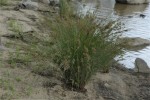 Loading... Please wait...
Loading... Please wait...
Our Products
Join our newsletter
Juncus Usitatis
Price:
$110.00
(including GST)
Common Name:
COMMON RUSH
PLEASE NOTE: Orders are by full tray only. Each tray contains 40 plants. When ordering, please choose how many trays you would like.
WHAT IT LOOKS LIKE:
- A perennial herbaceous plant typically growing in dense clumps with upright stems that can reach heights of up to 1 meter.
- The stems are cylindrical and smooth, with a deep green coloration.
- The plant produces small, inconspicuous flowers clustered at the ends of the stems, which eventually develop into brown capsules containing numerous seeds.
- Characterised by its slender, linear leaves that arise from the base of the stem and taper to a fine point.
WHERE IT GROWS & WHY:
- Found in a variety of habitats, including wetlands, swamps, marshes, and along riverbanks and streams.
- Thrives in moist, waterlogged soils but can also tolerate periodic inundation and drought conditions.
- Also common in common on clays & clay loams.
- Plays a crucial role in stabilising soil and preventing erosion, making it an important component of riparian zones and wetland ecosystems.
- The dense growth habit provides valuable habitat and shelter for a variety of wildlife, including birds, insects, and small mammals.
MANAGEMENT/SIGNIFICANCE:
- Often used in wetland rehabilitation and restoration projects due to its ability to colonize disturbed areas and improve soil stability.
- Valued for its ornamental qualities and is sometimes cultivated in garden ponds and water features.
- In landscaping, Australian rush can be used to create naturalistic borders or as a component of rain gardens and bioswales.
SIMILAR PLANTS:
- Similar plants include other members of the Juncus genus, such as Juncus Polyanthemos (Australian Silver Rush), which share similar growth habits and ecological roles in wetland ecosystems.
Image Source: Fagg, M via Australian National Botanic Gardens (ANBG)
- Home
- Grasses, Rushes and Sedges
- Juncus Usitatis
